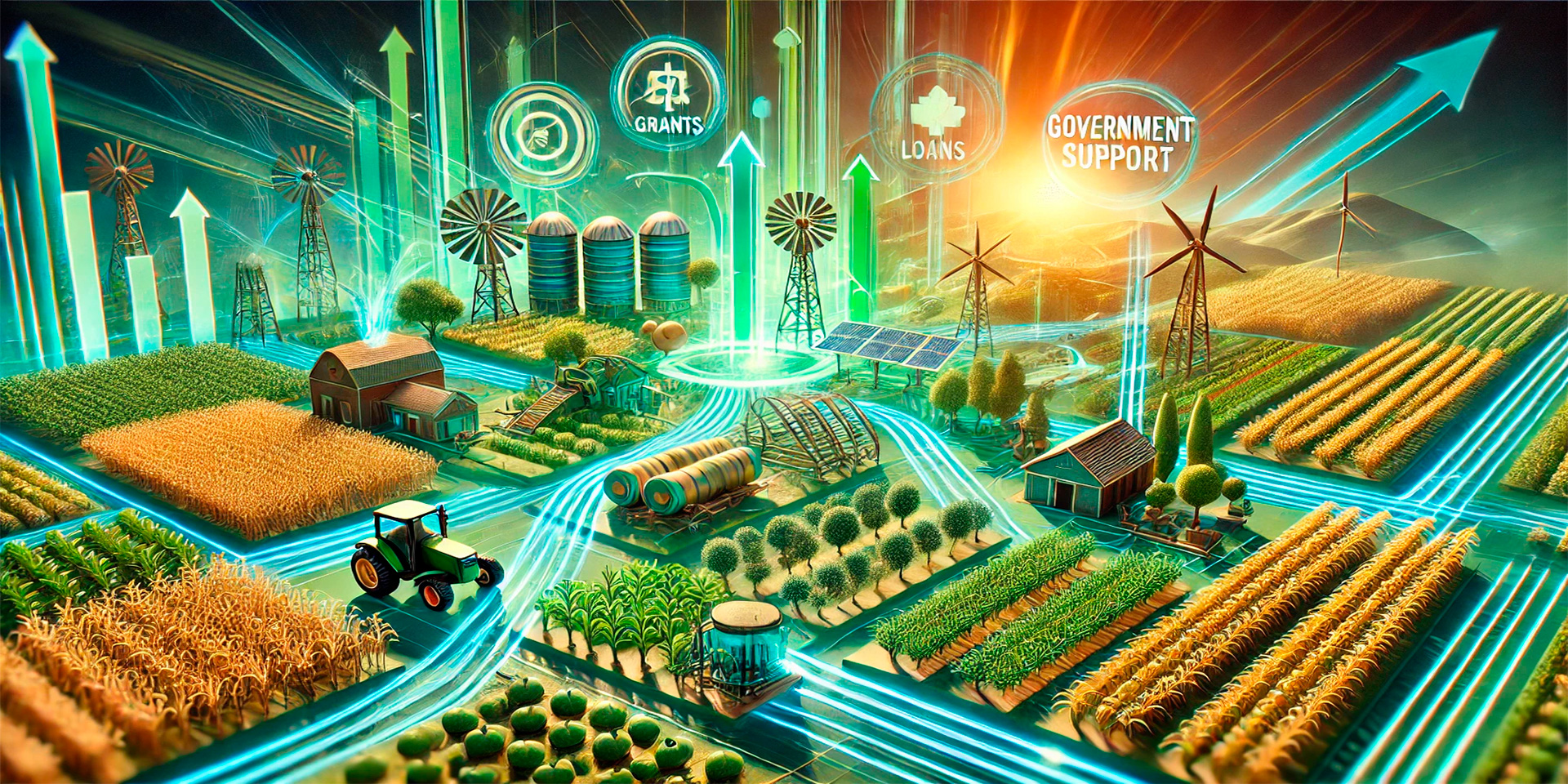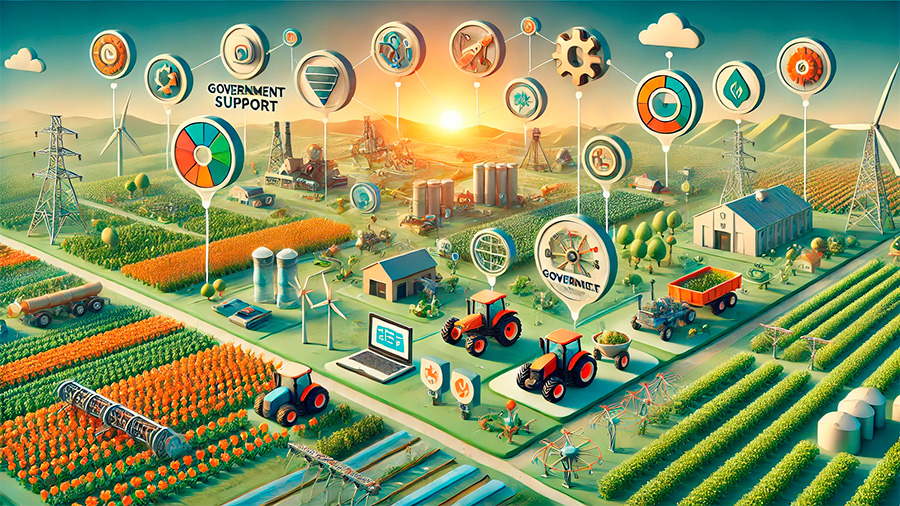
Global Impact of Agrotechnology: How Government Funding is Boosting Food Security
Government lending and funding programs are accelerating the adoption of agrotechnology, transforming farming methods and shaping the future of agriculture worldwide. Agrotechnology, which encompasses innovations like precision farming, automation, and sustainable agricultural practices, has the potential to increase crop yields, reduce environmental impact, and improve the efficiency of food production. However, many farmers and agricultural enterprises face significant financial barriers to adopting these technologies. Government funding programs play a crucial role in overcoming these barriers by providing the financial support needed to invest in agrotechnology and modernize farming operations.
This article explores how government lending and funding programs are driving the adoption of agrotechnology, the types of technologies being implemented, and the broader impact on global agriculture.
The Role of Government Lending in Supporting Agrotechnology
Adopting new agricultural technologies can be expensive, especially for small and medium-sized farms that operate with limited resources. Government lending programs are designed to bridge this financial gap by providing farmers with access to low-interest loans, grants, and subsidies that support the purchase and implementation of agrotechnology. These programs not only make it easier for farmers to adopt cutting-edge technologies but also encourage innovation in the agricultural sector as a whole.
1. Low-Interest Loans for Agrotechnology
One of the primary ways governments support the adoption of agrotechnology is through low-interest loan programs specifically tailored for the agricultural sector. These loans make it more affordable for farmers to invest in advanced technologies such as precision irrigation systems, automated machinery, and data-driven farming tools. By offering favorable terms, such as extended repayment periods and lower interest rates, these programs reduce the financial risk associated with investing in new technologies.
Benefits of low-interest loans for farmers:
- Affordable technology adoption: Low-interest loans enable farmers to invest in agrotechnology without taking on excessive financial risk.
- Increased productivity: Access to new technologies allows farmers to increase efficiency and yields, improving overall profitability.
2. Government Grants and Subsidies
In addition to loan programs, many governments offer grants and subsidies to support the implementation of agrotechnology. These funds can be used to cover the cost of purchasing new equipment, upgrading existing infrastructure, or training farm workers on how to use advanced technologies. Grants and subsidies are often aimed at promoting sustainable farming practices, such as reducing water usage, minimizing pesticide use, and increasing soil health, all of which can be achieved through agrotechnology.
How grants and subsidies drive agrotechnology adoption:
- Reduced upfront costs: Grants and subsidies lower the initial investment required for adopting new technologies, making it more accessible for farmers.
- Promotion of sustainability: Government funding often incentivizes the adoption of environmentally friendly technologies that improve sustainability in agriculture.

Types of Agrotechnology Supported by Government Funding
Government funding programs are helping farmers adopt a wide range of innovative technologies that enhance productivity, reduce costs, and promote sustainability. From precision farming tools that optimize resource use to automation systems that reduce labor costs, these technologies are revolutionizing modern agriculture. Below are some of the key types of agrotechnology that are being supported through government lending and funding programs.
1. Precision Farming Technologies
Precision farming involves the use of data-driven tools and technologies to optimize farming practices. This can include GPS-guided machinery, drones for monitoring crops, and sensors that track soil moisture levels or nutrient content. Precision farming allows farmers to apply inputs like water, fertilizer, and pesticides with greater accuracy, reducing waste and improving crop yields. Government funding is helping to accelerate the adoption of these technologies by providing financial support for purchasing and implementing precision farming systems.
Advantages of precision farming:
- Resource efficiency: Precision farming minimizes waste by ensuring that resources are applied only where they are needed.
- Increased yields: Optimized farming practices lead to higher crop yields and improved profitability.
2. Automation and Robotics
Automation is another area of agrotechnology that is transforming farming practices. Automated machinery, such as tractors, harvesters, and planting equipment, can perform tasks more efficiently and consistently than manual labor. Robots equipped with artificial intelligence (AI) can also be used for tasks such as weeding, planting, and crop monitoring, reducing the need for human labor and lowering operational costs. Government loans and grants are enabling farmers to invest in these automated systems, helping to modernize farms and increase operational efficiency.
Benefits of automation in farming:
- Labor savings: Automated machinery reduces the need for manual labor, helping farmers save on labor costs.
- Improved efficiency: Automation allows tasks to be completed faster and with greater accuracy, improving overall farm productivity.
3. Sustainable Farming Solutions
Sustainability is a growing priority in global agriculture, and government funding is increasingly directed toward technologies that promote environmentally friendly farming practices. This includes technologies that reduce water consumption, improve soil health, and minimize the use of chemical inputs like pesticides and fertilizers. Sustainable farming solutions, such as drip irrigation systems, composting technologies, and renewable energy-powered machinery, are being adopted by farmers worldwide, thanks to government support.
How sustainable technologies benefit agriculture:
- Environmental impact: Sustainable technologies reduce the environmental footprint of farming, helping to conserve natural resources.
- Long-term cost savings: By reducing the need for water, energy, and chemical inputs, sustainable farming practices lower operational costs in the long run.

The Global Impact of Government-Funded Agrotechnology
As government lending and funding programs support the widespread adoption of agrotechnology, the global agricultural landscape is being transformed. Farmers in both developed and developing countries are benefiting from increased productivity, reduced environmental impact, and improved food security. The impact of government-backed agrotechnology initiatives extends beyond individual farms, influencing entire food systems and contributing to global sustainability goals.
1. Boosting Food Security
One of the most significant benefits of agrotechnology is its potential to enhance food security by increasing agricultural productivity. With the global population expected to reach nearly 10 billion by 2050, there is growing pressure on the agricultural sector to produce more food using fewer resources. Government funding for agrotechnology helps farmers adopt methods that increase crop yields, reduce food waste, and improve the resilience of food systems. As a result, agrotechnology plays a critical role in addressing global food security challenges.
Role of agrotechnology in food security:
- Increased crop production: Agrotechnology allows farmers to grow more food on the same amount of land, helping to meet the demands of a growing population.
- Reduced food waste: Technologies like precision farming help minimize losses by optimizing inputs and reducing crop damage.
2. Advancing Sustainable Agriculture
Sustainability is a key focus of government-funded agrotechnology initiatives. As the agricultural sector faces increasing scrutiny over its environmental impact, government programs are helping farmers adopt practices that reduce greenhouse gas emissions, conserve water, and protect biodiversity. By supporting the adoption of technologies that promote sustainability, governments are contributing to the long-term viability of the agricultural sector and helping to meet global climate goals.
Sustainable agriculture benefits:
- Lower environmental footprint: Technologies that reduce chemical inputs, water usage, and energy consumption contribute to more sustainable farming practices.
- Resilient farming systems: Sustainable farming technologies help farmers adapt to climate change by improving soil health and water management.
The Future of Government-Funded Agrotechnology
As the demand for sustainable and efficient food production grows, government funding for agrotechnology is likely to increase in the coming years. Emerging technologies such as artificial intelligence, blockchain for supply chain management, and advanced biotechnology hold promise for further transforming agriculture. Government-backed research and development programs will play a critical role in advancing these technologies and ensuring that they are accessible to farmers around the world.
1. Emerging Technologies in Agriculture
Emerging technologies such as AI-powered analytics, gene editing for crop improvement, and blockchain-based supply chain solutions are poised to revolutionize the agricultural sector. These technologies have the potential to further increase productivity, improve food traceability, and enhance farm management practices. As governments continue to invest in research and development, these emerging technologies will become more widely available, driving the next wave of agricultural innovation.
Potential impact of emerging agrotechnologies:
- AI and data analytics: AI-powered tools can provide real-time insights into crop health, soil conditions, and weather patterns, helping farmers make more informed decisions.
- Biotechnology advancements: Gene editing and other biotechnologies can improve crop resilience to pests, diseases, and environmental stresses, boosting yields.
2. Expanding Access to Agrotechnology
While large-scale farms in developed countries have been the primary beneficiaries of agrotechnology, governments are increasingly focusing on expanding access to smallholder farmers in developing regions. By providing targeted funding, technical assistance, and infrastructure support, governments can help smallholder farmers adopt agrotechnology and improve their livelihoods. Expanding access to these technologies is essential for creating more equitable and sustainable agricultural systems worldwide.
How governments can expand access to agrotechnology:
- Targeted funding for smallholders: Government grants and loans specifically aimed at smallholder farmers can help bridge the financial gap and promote technology adoption.
- Capacity-building initiatives: Governments can provide training and technical support to ensure that farmers have the knowledge and skills to effectively implement agrotechnology.
Conclusion
Government lending and funding programs are driving the global transformation of agriculture by supporting the widespread adoption of agrotechnology. These programs make it easier for farmers to invest in precision farming, automation, and sustainable practices, leading to increased productivity, reduced environmental impact, and improved food security. As governments continue to fund agrotechnology initiatives, the agricultural sector is poised for further innovation, creating a path to success for farmers worldwide.
